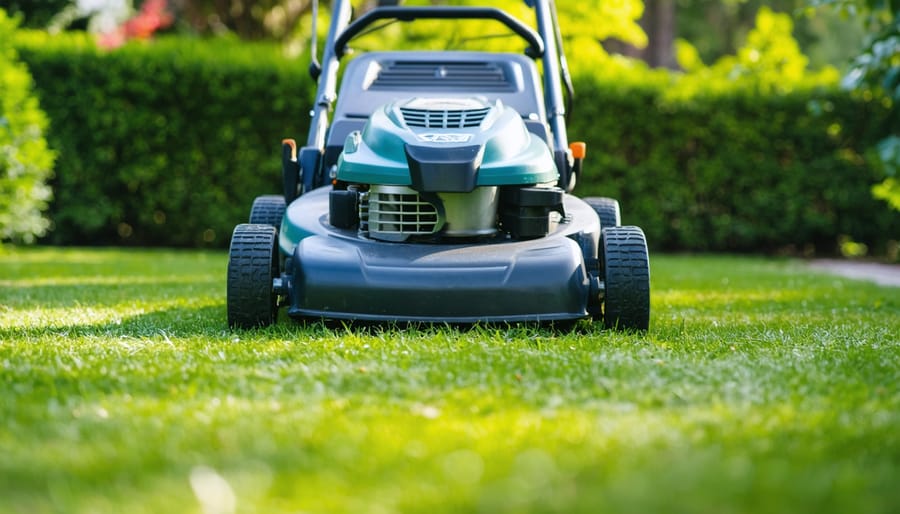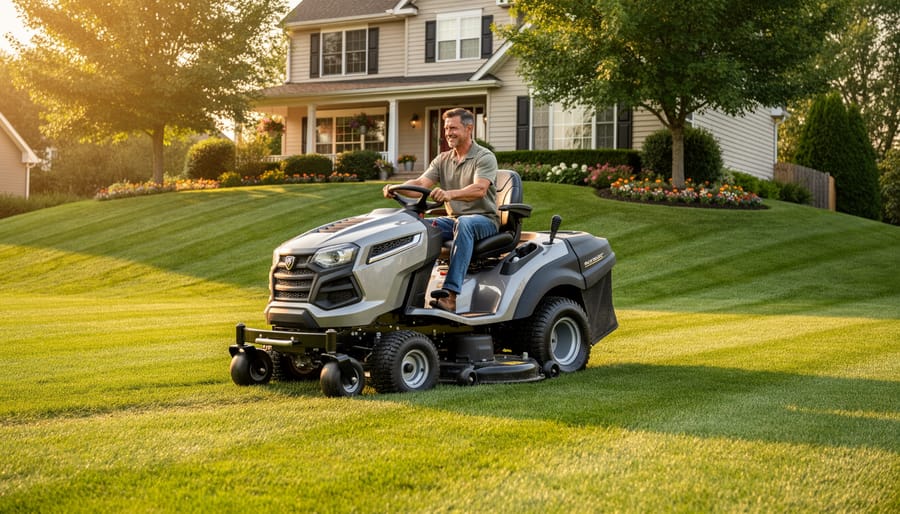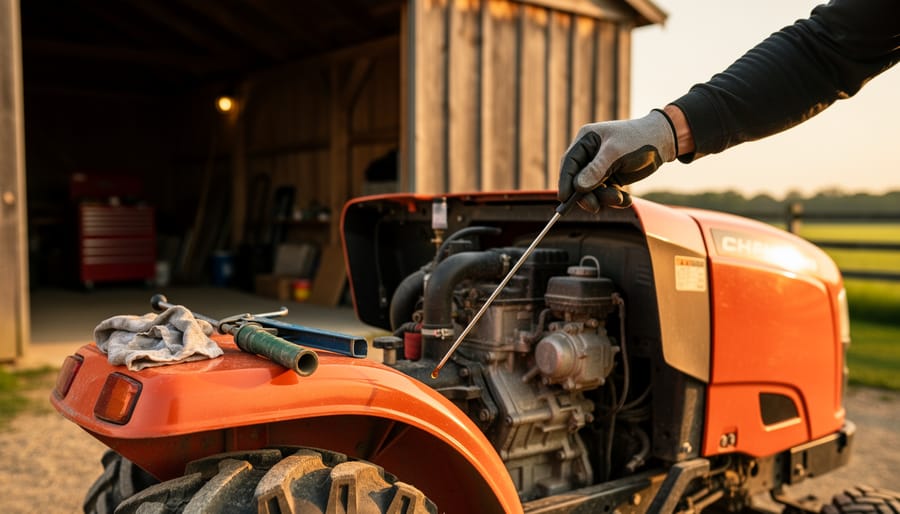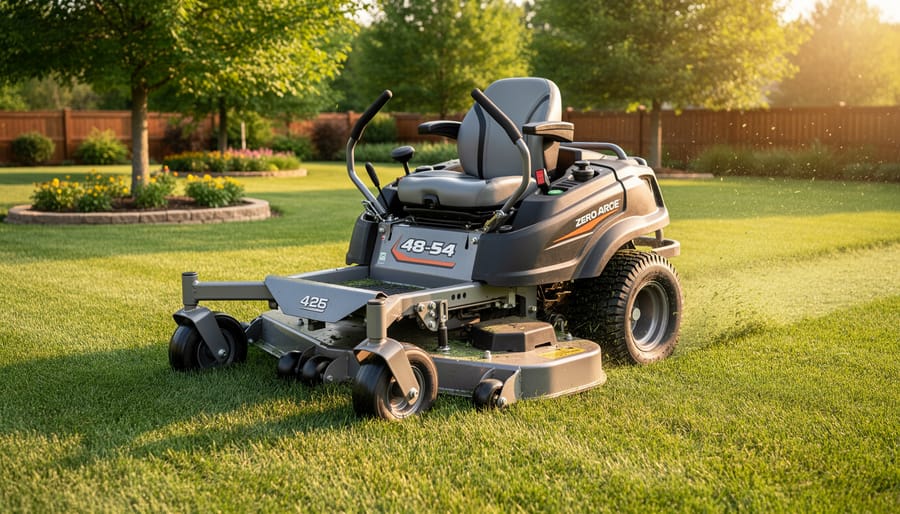Modern lawn mower safety features stand as the crucial barrier between routine yard maintenance and potentially devastating accidents. Every year, over 80,000 Americans require hospital treatment for lawn mower-related injuries – a statistic that underscores the vital importance of understanding and properly utilizing these safety mechanisms.
Today’s lawn mowers incorporate sophisticated safety features that have revolutionized garden equipment protection. From automatic blade-stop systems that halt cutting mechanisms within seconds of releasing the operator presence control, to impact-resistant deck designs that contain flying debris, these innovations have transformed a once-dangerous tool into a significantly safer household essential.
Whether you’re a seasoned landscaper or a first-time homeowner, familiarizing yourself with your mower’s safety features isn’t just about compliance – it’s about protecting yourself, your family, and anyone nearby while maintaining your lawn. As we explore the essential safety mechanisms built into modern mowers, you’ll discover how these ingenious features work together to prevent accidents and ensure peace of mind during every mowing session.
This comprehensive guide breaks down the most important safety features you need to know about, explaining how they function and why they matter for your lawn care routine.
Blade Safety Systems: Your First Line of Defense
Blade Brake Control Systems
Blade brake control systems are one of the most crucial safety features in modern lawn mowers, designed to protect both the operator and anyone nearby. These ingenious mechanisms ensure that the mower’s blade stops rotating within seconds of releasing the operator presence control lever, typically located on the mower’s handle.
The system works through a combination of mechanical and sometimes electrical components. When you squeeze the control lever, it engages the blade, allowing it to spin at the optimal speed for cutting grass. This spinning motion, combined with proper blade sharpness, ensures efficient mowing. The moment you release the lever – whether intentionally or accidentally – the brake mechanism activates, bringing the blade to a complete stop, typically within three seconds or less.
This rapid response time is particularly important when you need to clear debris from the discharge chute, empty the grass bag, or if you accidentally lose control of the mower. Modern blade brake systems are designed to be fail-safe, meaning they default to the “brake engaged” position if any component fails.
Many newer models feature enhanced blade brake clutch (BBC) systems, which allow the engine to continue running even when the blade stops. This convenient feature eliminates the need to restart the engine when emptying the grass catcher or moving across non-grass areas, saving time and reducing wear on the starter mechanism.
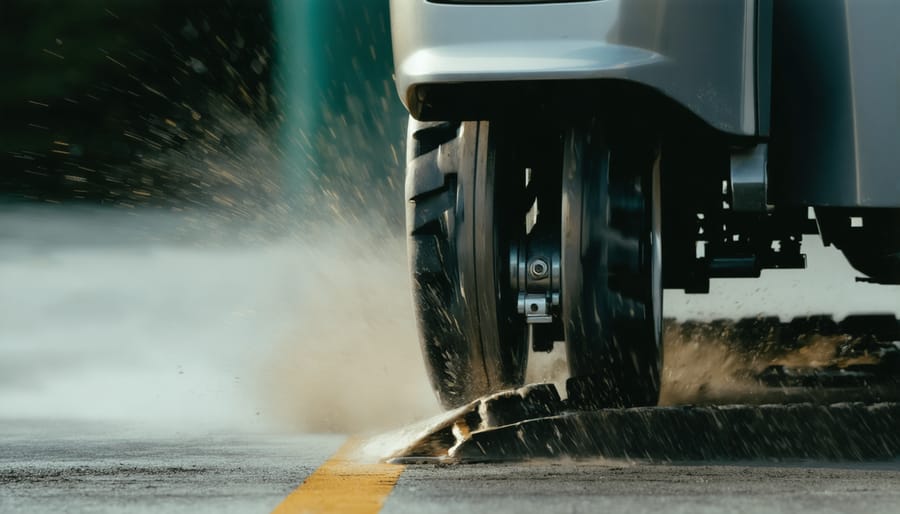
Blade Guards and Discharge Chutes
Blade guards and discharge chutes are essential safety features that protect you from one of the most dangerous parts of your lawn mower – the spinning blades. The blade guard, typically made of durable metal or high-impact plastic, forms a protective housing around the cutting deck, preventing direct access to the blades during operation and maintenance.
Modern lawn mowers come equipped with carefully designed discharge chutes that direct grass clippings and debris away from the operator and any bystanders. These chutes are angled to ensure clippings are expelled safely downward or into a collection bag, reducing the risk of flying debris that could cause injury.
Many models now feature adjustable discharge chutes with deflector shields that you can position based on your mowing conditions. This flexibility allows you to direct clippings exactly where you want them while maintaining optimal safety. Some eco-friendly models even include mulching guards that keep clippings contained under the deck, breaking them down into natural fertilizer for your lawn.
Regular inspection of these safety features is crucial. Check for any cracks, loose components, or damage that might compromise their effectiveness. If you notice your discharge chute or blade guard is damaged, replace it immediately – never operate your mower without these vital protective components in place. Remember, these features aren’t just add-ons; they’re fundamental safety measures that protect you and others around you while mowing.
Engine Control Safety Features
Dead Man’s Switch
The dead man’s switch, also known as the operator presence control (OPC), is one of the most crucial safety features on modern lawn mowers. This ingenious mechanism automatically stops the mower’s engine or blade rotation when you release the control bail or lever, typically located on the mower’s handle. Think of it as your mower’s guardian angel, always watching out for your safety.
This feature was developed with a simple yet powerful principle: if the operator loses control of the mower – whether due to a slip, fall, or other emergency – the machine should stop immediately. When you release the control lever, a spring-loaded mechanism activates, cutting power to either the engine or the blade engagement system, depending on the mower model.
For push mowers, the dead man’s switch usually requires you to hold down a bar against the handle while operating. On riding mowers, it often takes the form of a seat switch that cuts the engine if you leave the seat while the blades are engaged. Some advanced models even incorporate additional safety measures, like requiring the operator to be seated before the mower can start.
Regular testing of your dead man’s switch is essential for safe mowing. Simply start your mower and release the control lever – the engine or blades should stop within a few seconds. If there’s any delay or malfunction, have your mower serviced immediately. Never attempt to bypass or disable this critical safety feature, as it could lead to serious accidents.
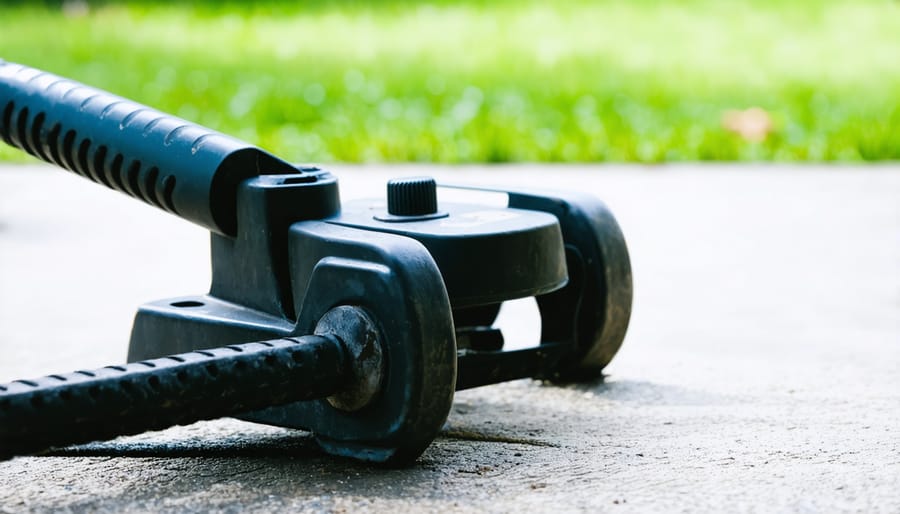
Key-Based Safety Systems
Modern lawn mowers incorporate sophisticated key-based safety systems that protect both the operator and those nearby. The most common feature is the safety key or ignition key, which acts as a master switch for the mower. When removed, it completely disables the engine, preventing unauthorized use, especially by children who might be curious about the equipment.
Many contemporary models feature advanced key systems that include a push-button start combined with a removable safety key. This two-step authentication process ensures the mower won’t start accidentally. Some manufacturers have even introduced models with coded keys, similar to car systems, adding an extra layer of security against theft.
The safety key system often integrates with other safety features, such as the operator presence control. If you remove the key while the engine is running, the mower will shut off immediately. This is particularly valuable in emergency situations where quick engine shutdown is necessary.
For battery-powered mowers, the safety key serves an additional purpose by breaking the electrical circuit between the battery and motor. This feature is essential for safe battery removal and maintenance work. Some models even include a backup key storage compartment, ensuring you always have a spare readily available.
Remember to store your mower key separately from the machine, preferably in a secure location out of children’s reach. It’s also wise to label your key to avoid confusion if you own multiple pieces of lawn equipment.
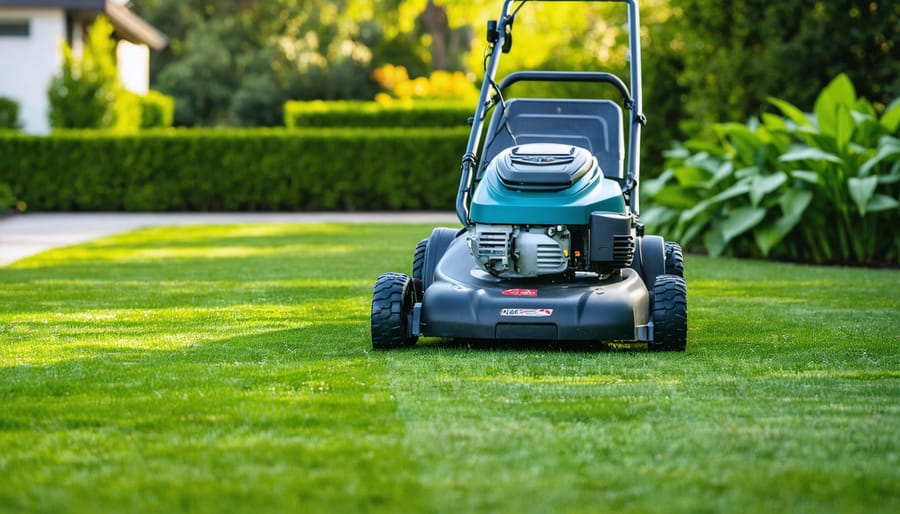
Modern Safety Innovations
Electronic Safety Sensors
Modern lawn mowers have embraced sophisticated electronic safety sensors that act as vigilant guardians while you’re mowing. These smart systems work tirelessly to prevent accidents and protect both the operator and bystanders. One of the most common electronic safety features is the operator presence control, which immediately stops the blade if you release the handle or leave the operator’s position.
Many newer models include advanced proximity sensors that can detect obstacles or people in the mower’s path. These sensors trigger an automatic shutdown if something unexpectedly enters the danger zone, preventing potential accidents before they happen. Some high-end models even incorporate cameras and artificial intelligence to distinguish between grass and foreign objects.
Another crucial electronic safety feature is the tip-over sensor. If your mower tilts beyond a safe angle, particularly on slopes or uneven terrain, these sensors instantly cut power to prevent rollovers and protect you from injury. Additionally, many electric and battery-powered mowers feature automatic shut-off systems that activate when the battery runs low, ensuring consistent power for safe operation.
Some manufacturers have introduced child safety features that use electronic key systems, similar to car ignitions. These prevent unauthorized operation and add an extra layer of security when storing your mower. The latest models even include smartphone connectivity, allowing you to monitor safety systems and receive alerts if any safety features are compromised.
Automatic Shut-off Features
Modern lawn mowers come equipped with several intelligent shut-off mechanisms that prioritize user safety. The most common is the operator presence control (OPC), often called the “dead man’s switch.” This essential feature automatically stops the engine and blade when you release the control bar, preventing accidents if you lose control of the mower or slip.
Many newer models feature tip-over protection, which cuts the engine if the mower tilts beyond a safe angle. This is particularly valuable when mowing on slopes or uneven terrain, where rollover risks are higher. Some advanced mowers even include collision detection systems that stop the blade when they sense unexpected resistance or obstacles.
Another crucial automatic safety feature is the blade brake clutch (BBC) system. This sophisticated mechanism allows the engine to continue running while stopping the blade rotation within seconds of releasing the control. It’s especially useful when you need to empty the grass bag or clear debris from your path without restarting the engine.
For riding mowers, seat sensors play a vital role in safety. These sensors immediately shut off the engine if the operator leaves the seat while the blades are engaged. Additionally, many models now include reverse operation switches that automatically disengage the blades when the mower is put into reverse gear, preventing back-over accidents.
These automatic shut-off features work together to create multiple layers of protection, making modern lawn mowers significantly safer than their predecessors.
Child Safety Features
Modern lawn mowers come equipped with several crucial safety features specifically designed to protect children from accidents. One of the most important is the operator presence control (OPC), also known as the “dead man’s switch.” This feature automatically stops the mower’s blade when the operator releases the handle, preventing accidents if a child approaches the mower unexpectedly.
Many manufacturers have incorporated automatic blade disengagement when the mower is put into reverse, reducing the risk of back-over accidents. This is particularly important since young children may not always be visible behind the mower. Some models also feature a safety key that must be inserted for the mower to start, preventing unauthorized use by children.
Given the serious nature of lawn mower accidents involving children, it’s crucial to understand the age restrictions for mower operation in your area. Additionally, newer models often include protective shields and guards that prevent access to hot engine parts and moving components.
Another valuable safety feature is the grass discharge chute deflector, which prevents stones and debris from being projected toward children who might be in the vicinity. Some manufacturers have also added bright safety colors and warning labels to help make both children and adults aware of dangerous areas around the mower.
Remember, while these safety features are essential, they should never replace proper adult supervision and safety practices when children are present during mowing activities.
Maintenance Tips for Safety Features
Keeping your lawn mower’s safety features in top condition is just as important as regular mower maintenance. These crucial components protect you and your family, so let’s explore how to maintain them properly.
Start by inspecting the blade brake control regularly. This essential safety feature stops the blade within seconds of releasing the handle. Test it monthly by starting the mower and releasing the control – the blade should stop quickly. If there’s any delay, have it serviced immediately.
The safety flap or discharge cover needs frequent cleaning to prevent grass buildup. Remove any accumulated debris that might prevent it from closing properly. Check for cracks or damage, and replace if necessary. Remember, never operate your mower with a damaged or missing discharge cover.
Dead man’s controls and safety switches require regular testing. These features shut down the engine when you release the handle. Press and release the controls several times to ensure smooth operation. If they stick or feel sluggish, apply a suitable lubricant or seek professional maintenance.
Keep the mower deck clean and rust-free to extend your mower’s lifespan and maintain optimal safety. Check for damage or wear that could compromise safety features. Pay special attention to the height adjustment mechanism – it should lock securely at each setting.
Finally, don’t forget about the automatic shut-off system. Test it monthly by attempting to start the mower with the blade engaged. If it starts, the system needs immediate attention from a qualified technician. Remember, well-maintained safety features aren’t just about compliance – they’re about protecting you and your loved ones while maintaining your lawn.
Choosing a lawn mower with robust safety features is not just about compliance with regulations – it’s an investment in your well-being and peace of mind. As we’ve explored throughout this guide, modern lawn mowers come equipped with various safety mechanisms that work together to protect you and your family from potential accidents and injuries.
Remember that even the best safety features are only effective when properly maintained and regularly checked. Make it a habit to inspect all safety components before each use, and never disable or bypass these crucial protective elements for the sake of convenience. A few extra minutes of safety checks can prevent hours of regret.
When shopping for a new lawn mower, prioritize models that offer comprehensive safety features, even if they come at a slightly higher price point. The cost difference is minimal compared to the value of preventing accidents and ensuring safe operation. Additionally, teaching family members about these safety features and proper mower operation helps create a culture of safety in your household.
By choosing and maintaining a lawn mower with proper safety features, you’re not just protecting yourself – you’re contributing to a safer gardening community for everyone.
